The Encampment
Ask someone to think of Valley Forge and they will nearly always envision an anonymous group of soldiers struggling against winter’s fury and clothed in nothing but rags. Certainly hardship did occur at Valley Forge, but the encampment experience could be characterized as “suffering as usual,” for privation was the continental soldier’s constant companion.
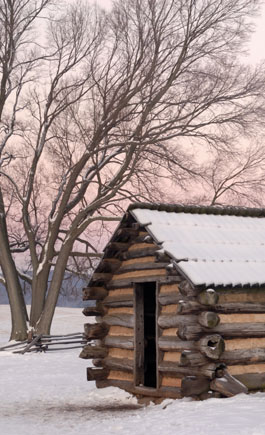 The reason many Americans picture Valley Forge as the pinnacle of
misery is that this early and romanticized version of the
encampment story became an important parable to teach us about
American perseverance. The portrayal of starving troops, however,
has kept us from getting to know the people of the Continental
Army — who they were, why they joined the army, and what they
accomplished at Valley Forge.
The reason many Americans picture Valley Forge as the pinnacle of
misery is that this early and romanticized version of the
encampment story became an important parable to teach us about
American perseverance. The portrayal of starving troops, however,
has kept us from getting to know the people of the Continental
Army — who they were, why they joined the army, and what they
accomplished at Valley Forge.
To better understand and appreciate what happened at Valley Forge it is helpful to know how the encampment fits into the context of the American Revolution (1775-1783).
In 1777 British strategy included a plan to capture Philadelphia, the patriot capital. To accomplish this, the British commander in chief, Sir William Howe, landed nearly 17,000 of His Majesty’s finest troops at the head of Chesapeake Bay. To oppose them, General George Washington marched his 12,000-man army from New Jersey. People often picture the Continental Army of 1777 as a ragtag bunch of inexperienced fighters. But Washington’s men fought with skill and were often on the offensive while campaigning against superior numbers of professional soldiers.
Although they lost two key battles, as well as Philadelphia, to the British, Washington’s soldiers emerged from these experiences with a renewed confidence in their fighting abilities. They only needed a little more training to reach their full potential.
As wintry weather approached, armies often withdrew to fixed camps. Transportation problems made large-scale winter operations infeasible. In choosing a site for quarters, Washington had to balance the Continental Congress’s wish for some type of winter campaign aimed at dislodging the British from the capital against the needs of his weary and poorly supplied army. By mid-December he had decided to encamp at Valley Forge.
From this location, twenty miles northwest of Philadelphia, the army was close enough to maintain pressure on the British yet far enough away to prevent a surprise attack. While the soldiers who entered camp on December 19, 1777, were not well-supplied, they were not downtrodden. This is attested to by an anonymous observer who recounted his visit to Valley Forge in the New Jersey Gazette on December 25:
“I have just returned from spending a few days with the army. I found them employed in building little huts for their winter quarters. It was natural to expect that they wished for more comfortable accommodations, after the hardships of a most severe campaign; but I could discover nothing like a sigh of discontent at their situation... On the contrary, my ears were agreeably struck every evening, in riding through the camp, with a variety of military and patriotic songs and every countenance I saw, wore the appearance of cheerfulness or satisfaction.”
Army records and eyewitness accounts speak of a skilled and capable force in charge of its own destiny. Rather than wait for deliverance, the army located supplies, built log cabins to stay in, constructed makeshift clothing and gear, and cooked subsistence meals of their own concoction. Provisions, though never abundant in the early months of the encampment, were available.
Shortages of clothing did cause severe hardship for a number of men, but many soldiers had a full uniform, and the well-equipped units patrolled, foraged, and defended the camp. The sound that would have reached your ears on approaching the camp was not that of a forlorn howling wind, but rather that of hammers, axes, saws, and shovels at work.
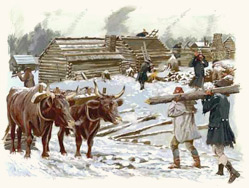
Under the direction of military engineers, the men built a city of 2,000-odd huts laid out in parallel lines along planned military avenues. The troops also constructed miles of trenches, five earthen forts (redoubts), and a state-of-the-art bridge over the Schuylkill River.
Disease, not cold or starvation, was the true scourge of the camp. Army returns reveal that two-thirds of the nearly 2,000 men who perished died during the warmer months of March, April, and May, when supplies were more abundant. The most common killers were influenza, typhus, typhoid, and dysentery. Dedicated surgeons, capable nurses, a smallpox inoculation program, and camp sanitation regulations limited the death tolls.
Perhaps the most important outcome of the encampment was the army’s maturation into a more professional force. The Continental Army was primed and ready to move on to the next level just as a charismatic former Prussian army officer, Baron Friedrich Wilhelm Augustus von Steuben, arrived in camp in February 1778.
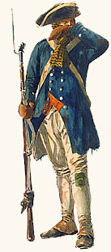 Von Steuben’s hands-on training program helped the army become a
more proficient marching machine. The Baron inspired a “relish for
the trade of soldiering” that gave the troops a new sense of
purpose and helped sustain them through many trials as they stuck
to the task of securing independence.
Von Steuben’s hands-on training program helped the army become a
more proficient marching machine. The Baron inspired a “relish for
the trade of soldiering” that gave the troops a new sense of
purpose and helped sustain them through many trials as they stuck
to the task of securing independence.
On May 6, 1778, the army joyously celebrated France’s alliance with and formal recognition of the United States as a sovereign power. The expected arrival of the French greatly altered British war plans and triggered their evacuation of Philadelphia in June.
Washington rapidly set troops in motion to bring on a general engagement with the enemy. On June 28, at the Battle of Monmouth, N.J., Washington’s men demonstrated their improved battle prowess when they forced the British from the field.
By summer Washington could claim that the war effort was going well. Valley Forge was not the darkest hour of the Revolutionary War; it is a place where an already accomplished group of professionals stood their ground, honed their craft, and thwarted one of the major British offensives of the war.
Common Ground
The troops who came to camp included men from all thirteen of the original states. The encampment brought together men, women, and children of nearly all ages, from all walks of life, from different ethnic backgrounds, and from various religions. While statistically most were of English descent, the ranks also included persons of African, American Indian, Austrian, Dutch, French, German, Irish, Polish, Portuguese, Prussian, Scottish, Spanish, and Swedish descent. Motivation for enlistment varied, but many who joined in the fight sought to secure their own blessings of liberty while they fought to gain their country’s independence from Britain. Many recent European arrivals sought fortune and honor by enlisting in the regiments of the states they now called home.
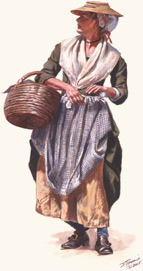 Women followed the army to be with their husbands and
contributed actively to the cause. The women present at Valley
Forge included hundreds of enlisted men’s wives who followed the
army year round, and some officers’ wives on extended
visits. The army compensated full-time women followers for
rendering such valuable services as laundering and nursing.
Women followed the army to be with their husbands and
contributed actively to the cause. The women present at Valley
Forge included hundreds of enlisted men’s wives who followed the
army year round, and some officers’ wives on extended
visits. The army compensated full-time women followers for
rendering such valuable services as laundering and nursing.
Promises of freedom motivated thousands of enslaved African Americans to join Continental and British forces. In the Continental Army, bound individuals yearning for liberty and wages served alongside freemen in search of a better life. The Continental Army was integrated and included many patriots of African descent.
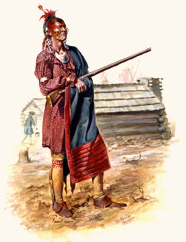 In order to preserve their culture and prevent encroachment upon
their rich western domain, most American Indians sided with the
British. Political, religious, and personal ties, however, led
some tribes to support the patriots. Hundreds of Indians
enlisted in the Continental Army and many others, engaged as
scouts in specialized units. One of the most notable
contributions came from the Oneida, who sent aid and a
contingent of warriors to Valley Forge.
In order to preserve their culture and prevent encroachment upon
their rich western domain, most American Indians sided with the
British. Political, religious, and personal ties, however, led
some tribes to support the patriots. Hundreds of Indians
enlisted in the Continental Army and many others, engaged as
scouts in specialized units. One of the most notable
contributions came from the Oneida, who sent aid and a
contingent of warriors to Valley Forge.
The successful conclusion of the Revolution marked only the beginning of the struggle for some individuals for personal liberty. As the sound of combat grew fainter, the battle for individual rights began.
Paintings courtesy of Don Troiani, www.historicalimagebank.com











